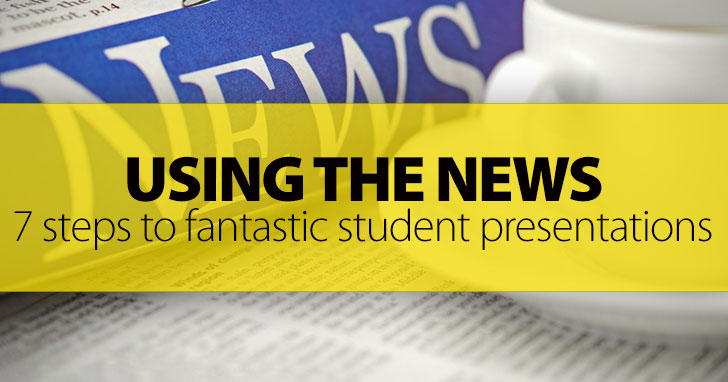Creative Current Events: 5 New Ways to Use Todays’ News in Class


My 16-25 year old students are smart, enthusiastic and tech-savvy, but very often I find a real lack of ‘worldliness’ and I think the ESL classroom is a great place to fill those gaps. I’m talking about knowing the names of the world’s continents and countries, and of major political, religious and historical figures. Just as importantly, students need to be aware of world events, familiar with the major trends and philosophies of our time, and conversant in the topic areas which will dominate this century, and their lives.
A recent survey of my high-level class revealed – to my amazement, I have to admit – that Twitter had become their main news source. Even more surprisingly, many could not name a cable news anchor, or a respected print journalist, or any more than a handful of the world’s great newspapers and journals. I’m the first to recognize that the digital age is driving our students’ media consumption. It’s just that I’m worried they’re missing out on great journalism, on incisive commentary and on that in-depth analysis which really helps us to understand the world around us.
This demands reading skills, of course. It also requires the confidence to open a newspaper, or click on an online article from The Economist or Britain’s excellent Guardian, unruffled by the high-level vocabulary and structures, and simply willing to give it a try. News-reading depends also on tackling something younger people are being trained to avoid: lengthy articles which require sustained focus. With practice, these problems fall away, allowing students to read the full range of scholarly and journalistic material, thereby enriching both their life experience and their language skills.
To meet this problem head-on, I developed a weekly 90-minute exercise to train newspaper reading, summarizing and presentation skills. Students have found this challenging and informative, and have grown more confident when discussing complex themes and international events. Just as importantly, this training has removed barriers which prevent broader, deeper reading, and awoken a more open-minded consciousness; the gaining of a more global awareness helps to mitigate prejudice, and alleviates the students’ fear of the unknown.
Beyond initial setup, the teachers’ role is largely supervisory, giving the students plenty of independence. The requirement to present to their classmates gives good reasons for them to carefully prepare. Here’s how it can be done:

A useful, initial step is to ensure that your own understanding of world trends is in good shape. When a news story breaks, consider whether you could describe why this might have happened, and what effects it could have. Check that you know the basics on the major world leaders, the systems of government in the leading nations, and the names and recent activities of the biggest companies. Anticipate questions the students might ask when something big happens.
The evening before class, or ideally at the beginning of the school day, browse the news and tease out between four and seven stories. Try to pick events which will be relevant to your students, which will have a global impact, or which connect with topic areas you’ve recently discussed. Check for interesting stories in these areas, among others:
A one-page handout detailing the stories, perhaps accompanied by hints on good sources, will enable students to start researching immediately. Typical questions include:
“The Chinese government announced a relaxation of the one-child policy this week. Why has this happened? Tell us about the current demographics in China and how this policy might affect Chinese society.”
“India launched a spacecraft to Mars yesterday. Give the class a short history of Mars exploration – are there any particularly successful probes? How many have failed? What does the Indian mission hope to achieve?”
“The investment bank J P Morgan is being fined $2.6 billion for its role in the Bernie Madoff scandal. Briefly summarize this infamous Ponzi scheme. Why was the bank found to be at fault? Who will receive the money?”
Research can be done alone, but I find that pairs or groups of three permits a more ‘integrated skills’ environment; the students read, write down notes, discuss the story and listen to what their partners have found. Once the groups are established, I let the students choose two stories (a favorite and a backup) and then use varying methods to decide who gets to choose first: age (in descending or ascending order), name (alphabetical or reverse), order they arrived at school, etc.
As the groups research, encourage the constant sharing of their findings, and plenty of note-taking. Ensure the students use their own words when taking notes, rather than copying verbatim from the news source. Assist in finding good sources, and avoiding disreputable, biased or poor-quality reporting; the ability to make these distinctions is a skill in itself, and many students need help with this. Once the notes look complete and useful, the students should organize their presentation and plan so that the speaking is divided equally.
Ensure the ‘audience’ is listening (computers closed, phones away, pens down) and encourage the students to speak clearly and slowly, avoiding new or overly technical vocabulary. Clarify and check words, names and concepts as needed. Ask a couple of comprehension questions.
Invite questions at the end of the presentation, and take time to discuss the news event with the class; are there any strong feelings about it? Try to bring in everyone, inviting opinions and predictions. Enthusiastic applause should conclude each presentation.
I hope this proves useful in helping students to discard their fear of reading, in developing their summarizing and presentation skills, and in expanding their horizons.